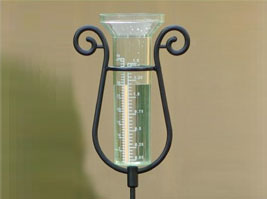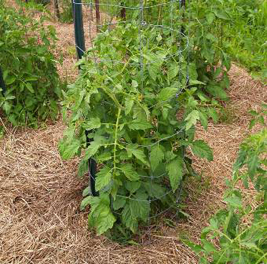How Much Water Does My Garden Need?

Watering in the garden can be difficult to decide during the time of year when summer rains are sporadic. Knowing exactly how much is needed for each plant can be tricky but as a rule of thumb water the garden only if there has been less than 1″ of rainfall per week.

The 1″ of Rain
The 1″ of rain is equivalent to a good solid 45 minutes to an hour of a medium rain storm. A rain gauge will tell you exactly how much each storm gives you but you can estimate or check your newspaper or local weather newscast for estimates of rainfall.
In soils like we have here on the farm which are very heavy clay type soils, our rainfall is normally plenty of watering for our garden, even in the heat of mid summer.
For soils that are more sandy, or silty (coastal or rocky areas) your garden may need additional
water to supplement sparse rainfall so that the plants have enough, especially on very hot days.
When temperatures go up, plants need more frequent watering to allow them to “breathe” properly and make chlorophyll and distribute nutrients through its “body”, much like you and I do.
When plants become too dry, they will wilt and can stress out which in turn causes problems with bugs, diseases and the plant’s overall health declines. Of course that means less fruit for us and eventual death for the plant. Consistency is the key to watering, making sure that water is available to the roots, down deep in the soil where it is cooler for them to do their job of feeding the plant above ground.

Drip Systems or Soaker Hoses
Drip systems or soaker hoses mimic a light to medium rainfall in the soil and seep the water down deep instead of running it all off down the hill where it doesn’t soak in.
You can even use old milk bottles with holes poked into the bottom to allow water to slowly drain out into the soil where the roots are.
Drip watering takes a bit longer than just running a hose but we set a timer and forget about it for an hour at a time, letting the trickling water soak in deep. Don’t forget to mulch heavily with a layer of hay or pine needles so that the moisture that you put in stays in as long as possible.
Our first instinct when watering is to wet down the leaves of the poor plant that is standing out in the garden in the sun. This can be detrimental to the plant, instead of helpful, as it can break leaves that are wilted or create excess humidity in the garden which harbors diseases.
Also, watering from above splashes water everywhere which allows weeds to germinate and grow in the garden. If you do water from above with a sprinkler, make sure that you do it in the morning so that there will be time during the day for the leaves to get plenty dry before nightfall. Cooler night temperatures, along with excess moisture encourages fungus and disease.
Watering Plants in Containers
Vegetables in Containers are a different story altogether. When you first plant a tomato or other vegetable into a large container or pot, there is generally a small root system and not as much need for watering.
Once the plant has grown to 4-5 feet tall, filled the pot with roots, and temperatures go up, it is time to give them all you’ve got when it comes to watering. Very large plants may even prefer to be watered twice a day. The key is to keep them from wilting too much by providing plenty of moisture.
A tray under your pots that holds water is a good idea, once the plant is this large, to prevent drying out. If you did that early in the season, when the root system was small, you could easily over water and kill the plant.
Once temperatures are in the 90’s, there is very little chance of over watering and much more likely that you will under water. Mulch works well for pots too and good compost mixed with the soil when you plant, or added to the top of the pot later, helps the potting soil hold water better by providing storage space for the water that you give them.
If you aren’t sure how dry your pots are, tilt them slightly to feel the weight of the pot, it will be considerably lighter when dry.



